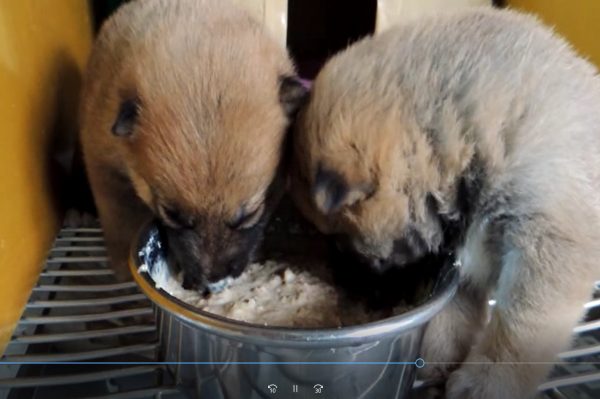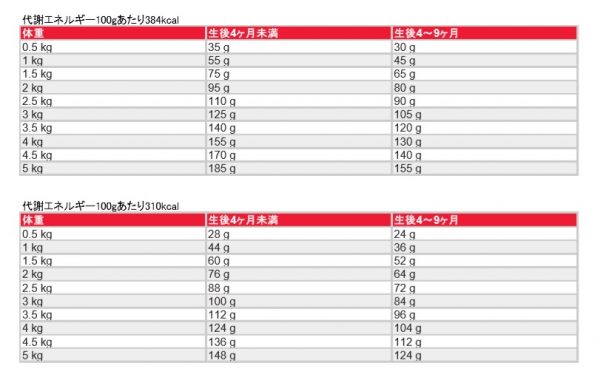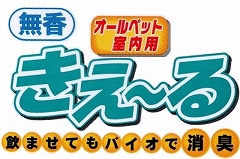Appropriate amount of food for the Mameshiba
| The longest-established kennel specializing in Mameshiba in Japan welcomes customers from all over the world. |
| How much should I feed my Mameshiba? |
| One of the most accessed pages on Hozanso’s website |
| Keywords: Amount of food for Mameshiba |
| There is no end to the inquiries we receive when people find out how much food Hozanso’s Mameshibas are fed. |
| They have purchased Mameshibas from other kennels or pet stores and make the following comments. |
| Mr. A. “We were instructed to feed about half a measuring spoon of laundry detergent during puppyhood, but that was a tremendously small amount.” |
| Ms. B: “I was told that about a coffee cup is the right amount for an adult dog, but that’s a small amount, isn’t it?” |
| Mr. C. “I was instructed to feed him less than my previous Chihuahua, but I thought it was too little, so I fed him about 100 grams, but he is 7 kg. Is it too big?” |
| etc. |
| Mr. C also sent me a picture of the dog with his email, he looks skinny rather than fat, but he is 7 kg. So he is big in height. |
| For Overseas Customers |
| At Hozanso, we feed Japanese dog food to our Mameshiba, and we tell our customers at the time of handover how much to feed them in the future on the assumption that they will continue to feed the same dog food in the future. |
| But it is difficult for international customers to get the same dog food. Different food has different energy levels, and the appropriate amount depends on that food. |
| However, since dogs are living creatures, there is no correct answer because of individual differences. However, since your Mameshiba will be a member of your family, please calculate and feed the appropriate amount of food to grow long and healthy with the following as a reference. |
 |
| Amount of food at other kennels |
| A person who purchased a Mameshiba from another kennel called, “I was told how much to feed him when he was a puppy, but how much should I increase the amount as he grows older?” |
| At the pet store, they told me to feed them less to keep them from getting too big, but they wouldn’t give me a specific amount. |
| When I asked the breeder, they gave me only vague instructions that an adult dog would need about a cup… |
| In some of the worst places, they are told to strictly stick to the “10 grams of yogurt and 20 grams of food” per serving for an adult dog. |
| 20 grams of food is about half a spoon of laundry detergent. |
| You can’t find breeders who clearly publicize the amount of food and calories of Mameshiba on the Internet, can you? |
| When a first-time dog owner buys a dog from a breeder, you think the breeder is right. |
| As a result, some people restrict the diet and let their Mameshibas die early, and come to us to buy their next Mameshiba somewhere else. |
| We are certain that the above food amounts because we have heard from owners who have had their Mameshiba die early. |
| We have also obtained documentary evidence, although we will not give it out here. |
Amount of food required per day |
| There is a basic number for the amount of food a dog should be fed. |
| Following are some data from the Ohio State University Veterinary Medical Center for reference. |
| How to calculate the amount of energy required for a day is |
| Resting Energy Requirements (RER) of Dogs x Factor by Life Stage |
| 1. find the resting energy requirement (RER). |
| How to calculate RER |
| RER (kcal/day) = 70*WT(kg)*0.75 |
| 1.5kg→79 |
| 2.0kg→105 |
| 2.5kg→131 |
| 3.0kg→158 |
| 3.5kg→184 |
| 4.0kg→210 |
| 4.5kg→236 |
| 5.0kg→262 |
| 5.5kg→289 |
| 6.0kg→315 |
| 2. multiply the RER obtained earlier by the life-stage-specific factor. |
| Example |
| 3-month-old puppy weighing 2 kg. |
| RER for a dog weighing 2 kg → 105 |
| Factors by life stage for puppies (under 4 months) → 3 |
| The way you found the amount of energy needed for a day was as follows. |
| RER of Dogs x Factor by Life Stage |
| Then, apply RER 105 and 3 life-stage-specific factor to that. |
| 105×3=315kcal |
| Daily energy requirement is 315 kcal |
| For 315 kcal/100g of feed, each gram has 3.15 kcal |
| The amount of food fed per day (g) is calculated by dividing the daily energy requirement by the number of calories (1 g). |
| 315÷3.15=100 |
| so the theoretical calculation is that 100 g should be fed per day. |
| Based on the average weight of the Mameshiba during its growth stage, the daily energy requirement and the amount of food it needs to eat are… |
| 2 months old, 1.5 kg → 237 kcal (75 g) |
| 3 months old, 2.0kg → 315kcal(100g) |
| 4 months old, 2.5kg → 262kcal (83g) |
| 5 months old, 3.5kg →368kcal(117g) |
| 6 months old, 4.0kg~4.5kg →410cal~472kcal(130g~150g) |
| 7 months old, 5.0kg~6.0kg →524kcal~630kcal(166g~200g) |
| However, if you continue to feed a 3-month-old puppy 100 g of food as calculated, he will tend to have soft stools. |
| Too much food tends to cause loose stools due to indigestion. |
| This can result in nutritional intake disorders. |
| On the other hand, a 10-month-old dog that has passed its growth period (the growth period ends around 6 months in early dogs) will tend to become fat if you continue to feed your dog the same amount of food as during its growth period. |
| Moreover, at four months of age, the amount of food they are fed is calculated to be less than at three months of age. |
| Therefore, the kennel averages the following based on experience. |
| The food in our kennel is 315 kcal/100g. |
| Kennel Average Amount and Kcal On the calculation formula |
| 2 months old 1.5 kg (about 70 g=220.5 kcal) =237kcal(75g) |
| 3 months old 2.0 kg (about 85 g=268 kcal) =315kcal(100g) |
| 4 months old 2.5 kg (about 100 g=315 kcal) =262kcal(83g) |
| 5 months old 3.5 kg (about 110 g=346.5 kcal) =368kcal(117g) |
| 6 months old 4.0kg~4.5kg (about 120g~130g=378~409.5 kcal) =410kcal~472kcal(130g~150g) |
| 7 months old 5.0kg~6.0kg (about 140g~160g=441~504 kcal) =524kcal~630kcal(166g~200g) |
| “All you have to do is … First, figure out the calorie content per gram of the food you are feeding.” Then, for example, if you feed a 4-month-old puppy a food with 3.5 kcal per gram, then, 315 ÷ 3.5 = 90, which tells you that the amount of food you should be feeding per day is 90 grams. |
| However, this is just a guideline and may increase or decrease slightly depending on the amount of exercise and body type. |
| Even this amount is considerably larger than the amount of food that dogs eat according to the standard chart for some famous food products in Japan. |
| The top image below shows 384 kcal/100g, and the bottom image shows 310 kcal/100g, since our kennel feed is 315 kcal/100g. |
| The amount of food our kennel feeds can be said to be high, even from the perspective of the amount of food fed by famous foods. |
 |
| Please feed your Mameshiba properly and without limiting the amount of food, using the amount of food in our kennel as a reference. |
Below is the story of how our puppies are not restricted in their diet and grow up eating well. |
| When I told a breeder at another kennel how much we feed our mameshiba dogs, he complained, “If people find out about it, they will say we are on a restricted diet!” |
| “Why don’t you just make small Mameshibas with a standard amount of food!” I said back to him…but after that, he no longer comes close to me. |
| In recent years, the number of people who come to our kennel for consulting about the future breeding of Mameshibas has increased. |
| I’m tempted to evaluate the size of the dogs because they are from other kennels ^^; |
| First, they will see the size of our Mameshibas, and then they will hold them in their arms. |
| There are many Mameshibas of similar size in other kennels. |
| However, when you hold them, you can see the difference. |
| Our kennel dogs are heavier. |
| They are heavy with muscles because they are well exercised. |
| Similar in size, they are heavier because of their higher bone density and muscularity. |
| Dogs raised on less food have no bone density and are as light as sponges. |
| Even if you let them play with our dogs, they are inferior in terms of their instantaneous power and acceleration, and they get outplayed. |
| And the teeth are too badly aligned. The size of the teeth is determined during growth. Teeth grow in accordance with their natural size, so you can’t get a decent set of teeth with a body that is forcibly small. |
| In addition, I ask how much they feed. |
| None of the Mameshibas from other kennels brought to our kennel in the past few years had been fed more than 100 grams per day as adults. |
| (The amount of food we feed a 4 month old puppy in our kennel is 100 grams) |
| Those who feed less say 40 grams a day for an adult dog. |
| When I heard 40 grams a day, I said, “Even our weaned puppies eat 60 grams a day. Adult dogs eat 3 to 3.5 times more.” |
| Then they realize how little food they have been raised with? And they cry. |
| Some people make the excuse, “My dog doesn’t eat a lot.” |
| “It is the result of a life of near abuse,” I gently admonish them. |
| Pups born to diet-restricted mothers will be born underdeveloped even before they are born. |
| Puppies are born undeveloped and are forced to restrict their diet. |
| There is no way she will grow up to be strong. But what happens if the mother’s diet is restored to the correct amount during pregnancy? The puppy will grow up to be very large inside the mother’s body and may even be difficult to deliver. The mother may be small, but the puppies growing in her womb will try to grow to a normal size because the mother’s body was originally large and the food restrictions have only made it smaller. As a result, even during pregnancy, if the diet is not restricted, the pups will grow large and will not be able to deliver naturally. Would you want to take such a risk and let her give birth? |
| Therefore, we sometimes refuse to accept a breeding. |
| The Mameshiba grows small with the proper amount of food. |
| With a restricted diet, a Shiba Inu can even stop growing at the size of a Mame-Shiba. |
| A large MameShiba that is still on a restricted diet and a MameShiba from our kennel that is eating very well. Please compare them. Which one is a real MameShiba? |
| It also means that if we were to hypothetically restrict the diet of our MameShiba, it would grow up smaller. |
| However, it is not a MameShiba, but an underdeveloped, immature Shiba. |
| Some pet shops even say, “If you don’t want your pet to be large, you need to restrict its diet a little bit.” |
| I believe that many people who come to this page are doing a thorough research to get a proper Mame-Shiba. |
| Before purchasing, please ask, “How much is this MameShiba fed? How much does an adult dog eat?” |
| If the amount of food required to raise the dog deviates from the above table, it is clearly a dietary restriction and should not be purchased. |
| We often hear the following comments from visitors to our kennel. |
| “I went around to other kennels and pet stores looking for a MameShiba, but I could tell at a glance that even though they were similar in age, they were healthy!” |
| “His fur is shiny, he’s energetic, and most of all, he’s round and thick-skulled!” |
| I had the impression that the puppies at the other kennel were still and listless, their fur lacked luster and they looked slender. I wondered if their lack of food made them less energetic. |
| I myself don’t visit other kennels, but I assume that the customers who come to the kennel have a certain feeling about it, since they say so. |
| If you are looking for a healthy, small Mameshiba without dietary restrictions, please do your research properly. |
| If you have a puppy from another kennel and came to this page because you have questions about the amount of food, please consider that if you feed him our standard amount of food, he may grow up to be bigger, but it is for his health. |
| We are not responsible even if you say that you bought a MameShiba elsewhere but it grew up to be as big as a Shiba with the amount of food at Houzansou. |
| We also hope that breeders who see this page will reconsider their dietary restrictions. |
| Please don’t go in the silly direction that 40 grams of food a day will grow them. |
Move to another page
FAQs about exporting a Mameshiba Inu Terms and conditions of the contract for the sale of living organisms Appropriate amount of food for the Mameshiba (current page) Preparation for acceptance (training) |




















